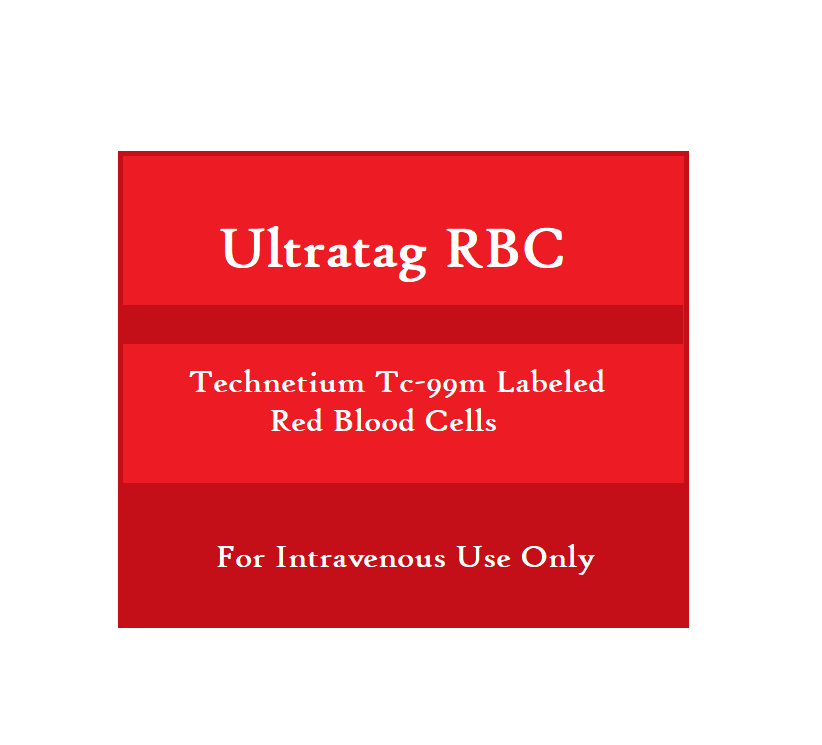This is prepared from the patients' blood by labeling it with TC-99 and then reinfused into the same individual. It is used as a radiopharmaceutical imaging agent for the detection of gastrointestinal bleeding, cardiac first pass, and gated equilibrium imaging.
Uses:
-
Diagnostic imaging:
- In cardiac first pass and gated equilibrium imaging, it is employed as a blood pool imaging agent.
- Detecting active gastrointestinal bleeding is another use for it.
Dose in Adults
Ultratag RBC Dose in Blood pool imaging:
- 10 to 20 mCi (370 to 740 MBq) intravenously for an average 70 kg patient.
Ultratag RBC Dose in GI bleeding:
- 10 to 20 mCi (370 to 740 MBq) intravenously for an average 70 kg patient.
Dose in Children:
Not indicated.
Pregnancy Risk Factor C
- It has not yet been tested in animal reproduction studies.
- Technetium Tc99m-labeled blood cells can cross into the placenta.
- The amount of fetal exposure varies depending on the dose, stage, and route of administration.
- Fetal harm also depends on how much of the drug is absorbed and what stage it is at. High doses can cause more harm.
- To reduce fetal risk, it is important not to perform elective procedures until after delivery.
- A pregnancy test should be done in all women who are pregnant.
- The procedure should be performed within 10 days of the onset menses.
Use of Technetium Tc99m red blood cells during breastfeeding
- Technetium Tc99m can be added to breast milk. It is recommended that you substitute formula for breast milk.
- If breastfeeding should be stopped temporarily, it is determined by the method of red blood cell labels (in vivo and in vitro).
- In vivo labeling allows you to stop breastfeeding after 6-12 hours, depending on the dose.
- Avoid close contact with your baby, and limit the time you spend in close proximity to them to no more than five hours per day.
- Breastfeeding mothers should stop drinking milk until breastfeeding is resumed. There are no recommendations regarding early breastfeeding.
- It is better to wait until after breastfeeding has stopped before you consider elective diagnostic procedures.
Dose in Kidney Disease:
- There are no dosage adjustments provided in the manufacturer's labeling.
Dose in Liver disease:
- There are no dosage adjustments provided in the manufacturer's labeling.
Side effects of Ultratag RBC infusion:
- There are no side effects listed by the manufacturer.
Contraindications to Ultratag RBC (Technetium Tc-99m labeled red blood cells):
There are no contraindications listed in the manufacturer's labeling.
Monitoring Parameters:
None mentioned.
How to administer?
IV:
- 1 - 3 ml of the patient's blood is taken. The blood is labeled with TC-99 (follow the manufacturer's instructions for transfer and reaction).
- The blood is then reinfused into the same patient from whom the blood was taken (for autologous use only). The blood is infused within 30 minutes or immediately after preparation.
Note:
- It is a radiopharmaceutical agent, appropriate precautions for handling and disposal should be taken.
Mechanism of action:
Tc 99m is used to label red blood cells from patients and they are then injected into the patient's body for gamma scintigraphic image.
Half-life elimination:
- About 29 hours
Excretion:
- About 25% is excreted in the urine.
International Brand Names of Technetium Tc-99m labeled red blood cells:
- Ultratag RBC
Technetium Tc-99m labeled red blood cells Brand Names in Pakistan:
No Brands Available in Pakistan.







